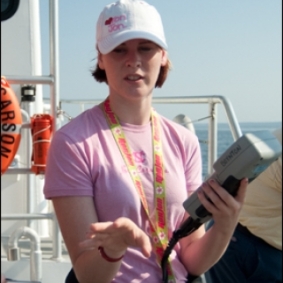Eight students will be presenting the summer work at the Ocean Sciences Meeting in March 2022!
Candice Canady, Southern Arkansas University
Class Year:
2010Mentor:
Halimeda Kilbourne, Ph.D.Project Title:
Analysis of Oxygen Isotope Ratios in the Coral Montastraea faveolata to Determine Climate Conditions in the Caribbean
Abstract:
In order to predict future changes in the Earth's climate, we must thoroughly understand past and present variability in the system. Due to the lack of instrumental data prior to the mid-19th century, it becomes necessary for paleoclimatologists to look at natural proxies such as coral cores in order to determine climatic events prior to instrumentation. Oxygen isotope ratios (δ18O) can be observed to determine the surface ocean temperature and hydrologic balance at the time of accretion of the coral's CaCO3 skeleton. In this study a core from a Montastraea faveolata specimen was analyzed for its oxygen isotope ratio in order to determine climatic behavior in the Caribbean from 1841-2001 and the results were compared alongside those of Kilbourne et al. (2008). The results received so far are only preliminary, but show a mean offset of 0.18±0.3 from 1841-1884 AD and 0.17±0.3 from 1957-2001 for the two cores, LPTA and LPPD, which is similar to the magnitude of intercoral variability found in other studies. The trend from 1841 to 2001 was -0.0013/year for this study, which is indistinguishable from the -0.0017/year found over the same time period in the data published previously from this reef tract (Kilbourne et al., 2008). More data is necessary to verify the claims made using this preliminary data, but these new data show that M. faveolata δ18O records are reproducible and confirm the strong warming signal in the Caribbean proposed Kilbourne et al. (2008).
Location:
Chesapeake Biological LaboratoryPresentations:
Canady, C.S.*, and K.H. Kilbourne. 2011. Surprisingly cool coral geochemistry based paleotemperatures in the Caribbean at the end of the Little Ice Age . ASLO Aquatic Sciences Meeting, San Juan, Puerto Rico .





